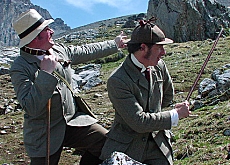Sherlock Holmes success no mystery

Sir Arthur Conan Doyle was so impressed by the Reichenbach Falls that he thought it an ideal place to kill off Sherlock Holmes. It was to prove a big mistake for the writer, but a blessing for the village of Meiringen in the Bernese Alps.
Conan Doyle had been writing about two Holmes stories a year when he and his wife set off on a tour of Switzerland in 1893. Frustrated with the character that had taken over his life, he came up with a plan to do away with him.
“In 1893 he wrote in his diary, which still exists, that he wanted to kill Sherlock Holmes at the Reichenbach Falls,” says Jürg Musfeld, director of the Park Hotel du Sauvage, where Conan Doyle is believed to have stayed during his visit to the village.
In The Final Problem, Conan Doyle hatched a plot to dispose of both Holmes and his arch-rival, the evil Professor Moriarty. In a final and fateful encounter, the two men clash at the falls and both fall to their death.
Englischer Hof
In the story, Conan Doyle renamed the hotel “the Englischer Hof”. Its proprietor, according to Dr Watson, who narrates the Holmes novels, was “Peter Steiler the elder” – “an intelligent man [who] spoke excellent English…”
The hotel has changed little since Watson and Holmes were guests, and the current director, Jürg Musfeld, is every much as hospitable and linguistically-talented as Steiler.
Musfeld has got to know Conan Doyle and Holmes far better than Steiler ever could have, and has made the most of his hotel’s famous past. “It was in 1987 when we first decided to erect a Sherlock Holmes statue, built by John Doubleday,” Musfeld says.
“Once we unveiled the statue in the presence of the English Sherlock Holmes Society, which included [the writer’s daughter] Dame Jean Conan Doyle, we decided to have Baker Street 221B recreated in our English church.”
The church is in reality a small chapel, and not only houses Holmes’ study as it was described and illustrated in the stories, but a treasure chest of memorabilia as well. It includes Holmes’ pipe, magnifying glass, deerstalker cap and a bust of the great detective.
There is also a rare complete collection of the monthly Strand magazines, which published the Holmes series, and an intriguing article from a 1910 edition of The Times. The newspaper’s Geneva correspondent reported that the Swiss railways banned sales of the crime stories because they were considered a bad influence on Swiss youngsters.
Also kept under lock and key is the statement Watson gave police after Holmes’ presumed death, along with crime exhibits, such as the neatly written note the sleuth wrote to Watson just before his struggle with Moriarty at the waterfall.
“My dear Watson [it reads]: I write these few lines through the courtesy of Mr Moriarty, who awaits my convenience for the final discussion of those questions which lie between us…”
Avid hiker
The spectacular waterfall can be seen from the Park Hotel du Sauvage. Visitors today can board the funicular railway to the site, or follow the same steeply wooded path taken by Holmes, Watson and Moriarty.
Conan Doyle, an avid hiker, is believed to have had his first view of the falls from above. “What one thinks today is that he walked from Grindelwald over the Grosse Scheidegg pass before coming down to Meiringen, so he did the trip from the opposite direction as Sherlock Holmes,” says Musfeld.
The Reichenbach Falls is a key site along the route over the Grosse Scheidegg, which is more popular today than it was during Conan Doyle’s visit during the golden age of tourism.
The falls have also become an important place of pilgrimage for Sherlock Holmes fans.
A white star and plaque mark the spot where the struggle between Holmes and Moriarty ensued. Watson had this to say about it: “Any attempt at recovering the bodies was absolutely hopeless, and there, deep down in that dreadful cauldron of swirling water and seething foam, will lie for all time the most dangerous criminal and the foremost champion of the law of their generation.”
Resurrection
Conan Doyle did such a convincing job in finishing off the detective that the sleuth became more popular than ever, and he was forced to resurrect him. Dozens of Sherlock Holmes stories followed, and his success overshadowed the writer’s other talents.
Conan Doyle was credited with designing swim vests for the British navy and helmets for the fire brigade, and in Switzerland he played a pioneering role in the development of alpine skiing.
A sketch made by Conan Doyle hangs in the stairwell of Meiringen’s Sherlock Holmes museum and illustrates the writer’s many interests. He portrays himself as an old donkey carrying a heavy load, and only a small fraction of that load is Sherlock Holmes.
(This story was first published in 2001.)
Sir Arthur Conan Doyle was attracted to Switzerland on many occasions between 1893 and 1925.
Through his writings and lectures, and together with his great friend Henry Lunn, he made a significant contribution to Swiss tourism.
In 1894, Doyle pioneered the first crossing on skis of the Mayenfelder Furka (2,445 metres) from Arosa to Davos, making history and popularising skiing.

In compliance with the JTI standards
More: SWI swissinfo.ch certified by the Journalism Trust Initiative











You can find an overview of ongoing debates with our journalists here . Please join us!
If you want to start a conversation about a topic raised in this article or want to report factual errors, email us at english@swissinfo.ch.